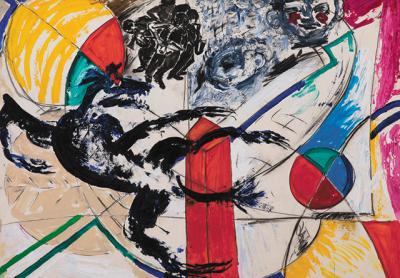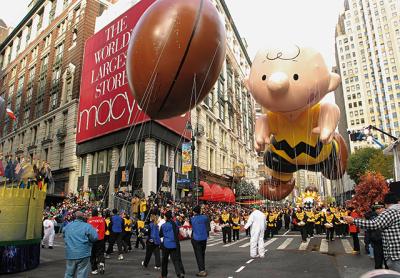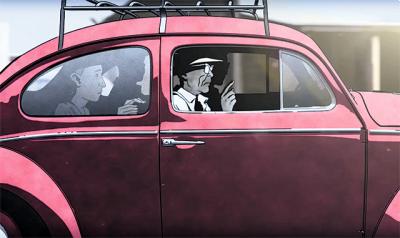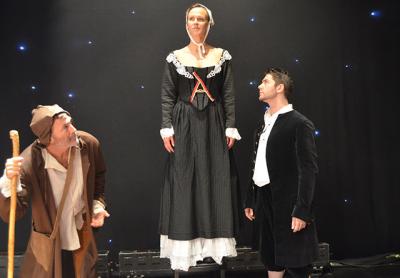Love, East Hampton Style
Love, East Hampton Style

It is clear early on in the Guild Hall exhibition “Connie Fox and William King: An Artist Couple” that there is fun to be had there. A sense of play and the absurd is introduced from the very beginning both by the artists and the exhibition’s curator, Gail Levin.
Dr. Levin, who has been a professor at the City University of New York for years in addition to being a curator and prolific writer on art and artists, decided to take the élan of her subjects as an overt and covert theme of the show.
Dr. Levin knew the couple socially, and there is a more intimate approach to the artists that registers with viewers. With works such as Ms. Fox’s “Dog Jazz” and Mr. King’s “Jazz Quartet,” along with his red vinyl sculpture and her take on it in a painting, it feels as though you might have stumbled into one of their conversations.
Mr. King was a curious artist, choosing unorthodox materials and working both with and against them to arrive at his forms. Red vinyl was a recurrent medium as was found wood, plaster, cast and cut metals with some dabbling in paint and drawings. Although there are some ceramic plates of Ms. Fox’s on view, she is represented almost entirely by acrylic paintings on canvas with a few drawings from the early days of her career. That she would paint one of Mr. King’s vinyl figures as opposed to recreating it in other ways, is a kind of cross-pollination or subsuming of his work, resulting in a creative offspring of sorts.
The couple met once, briefly, decades before they found themselves both playing fiddles in a bluegrass band formed by Audrey Flack, another artist and part of their circle. In a tour of the exhibition during its installation, Dr. Levin said Ms. Fox was classically trained on the violin, whereas Mr. King was self-taught.
In addition to their love of music, Dr. Levin said their interest in and reverence for early Modernism was a unifying theme. Ms. Fox was an admirer of Paul Klee, Vasily Kandinsky, and Robert and Sonia Delaunay. Mr. King took Pablo Picasso, Elie Nadelman, and Constantin Brancusi as influences.
Although Ms. Fox adopted Abstract Expressionism for a time, under the mentorship of Elaine de Kooning, who became a friend when both artists were in Albuquerque in 1957, she did not work in that manner for long. She liked the freedom, but the lack of content led her elsewhere.
The earliest works of hers in the show reference things, flowers in particular. Drawn around 1955 and 1967, “Self Portrait as a Flower” and “The Flower Lifts (Self as Flower),” seem more tuned in to Georgia O’Keeffe. But the later drawing has more bite. It is too abstracted to be Surreal in the usual sense, but the “self” in the center of the petals is depicted literally as a cloud of being, with a stern face scribbled in the middle. Even though it seems playful, she’s no longer playing, at least at being an artist. Her voice has formed.
Mr. King gave some early drawings here to Ms. Fox as part of their courtship in 1983. One was a self-portrait in pastel and charcoal. He looks sharp and blurry at the same time. Known for assuming the character of others in his work, it is one of his few straightforward depictions of himself. That he dedicated the drawing to her, almost a decade after its execution, seems meaningful.
Other works in the show highlight their mutual admiration for Marcel Duchamp. Ms. Fox has a painting titled “Marcel’s Star: You don’t have to be a star baby to be in my show” from 1993 that includes a black star at the center of a receding frame. Its reference is the star Duchamp shaved into his hair that was photographed by Man Ray.
Mr. King’s self-portraits take on Duchampian guises such as Ancient 9Egyptian queens, earlier Modernists like the sculptor Barbara Hepworth, who died in 1975, and Cindy Sherman, a contemporary artist and neighbor in Springs. While enjoying cross-dressing in his art, he also went cross-species, as in his “Bill-Dogg Hampton” sculpture from 1983, in which a smiling dog head is set atop a white-suited male’s body.
They were one in a long line of artistic couples who settled on the South Fork, and the show includes works that touch on that theme. There are photos and renderings they did of themselves as well as portraits of other couples such as Joan Semmel and John Hardy and April Gornik and Eric Fischl.
Place is also a recurrent theme: Ms. Fox’s paintings inspired by Sammy’s Beach, a subject to which she has dedicated much of her recent art, are included. They remind us how much the landscape continues to attract and inspire artists who come here to work and sometimes even fall in love.
The exhibition, shown concurrently with “Michael Knigen: The Holocaust and Anne Frank” and “William S. Heppenheimer,” will remain on view through Dec. 31.




